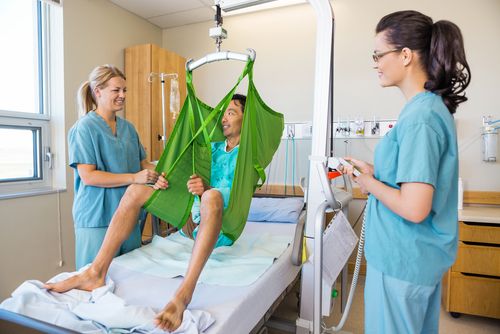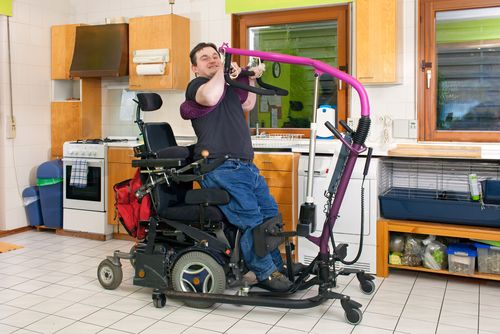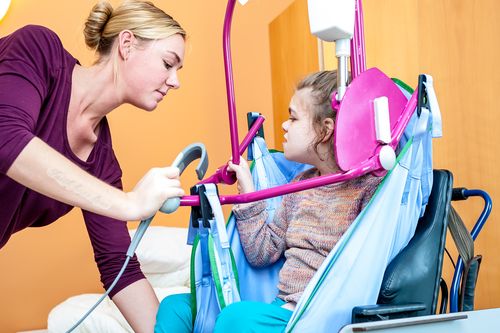 Written by Mike Price, OT
Written by Mike Price, OT
As more people today find themselves in home caregiving roles for their loved ones at a higher rate than ever before, the risks of injury for both the patient and the caregiver are raised significantly as well. When over 30,000 injuries are sustained by trained nurses while engaging in patient lifting tasks, you know the number is much higher for the growing number of untrained family caregivers.
While there are a number of daily living activities that both professional medical staff and family caregivers perform for others every day, moving their patients from place to place can be one of the most dangerous, for both the patient and the caregiver. Without the right equipment in place, the patient can be injured with twisted or incorrect body movements, and is much more likely to fall. Caregivers who don’t use assistive lifting equipment are at a much higher risk for lifting accidents, such as strains, sprains, and overexertion injuries.
One of the most common transfer aids, especially for patients who are unable to bear most of their weight, is the patient lift. Whether an innovative new electric model or the standard manual workhorse Hoyer lift, patient lifts are an integral part of most caregiving environments.
Although all patient lifts are designed to assist in safely moving a person from point A to point B, they are available in a wide variety of styles and options to accommodate a range of patient needs. Because this is such an important purchase, and it’s absolutely crucial to choose the right patient lift to meet your individual needs, we have gathered our extensive experience and knowledge into this buying guide to help you find exactly the right patient lift for you or your loved one.

In the ever-evolving world of modern patient lifts, innovations constantly abound, making these assistive devices safer and more comfortable than ever before. Quality designs ensure ease of use for both the patient and caregiver, with a host of differentiating features to fulfill specific requirements.
In order to better choose the right lift, it’s important that you first consider the unique needs of the patient. Knowing about the different types of patient lifts will help you select the one that most closely addresses your needs.
One of the most important considerations in choosing a patient lift is whether you need a manual or electrically-powered design.
Manual lifts are more affordable, and typically utilize hydraulics or gas for their operating power. The well-known Hoyer lift is a manual, hydraulic patient lift commonly used in hospitals and for home health care. Manual lifts offer the added benefit of always being operational as they don’t require an electric power source. They’re a good choice for most patients, as they provide general versatility to perform a range of transfers, even from the floor. But they may be a bit difficult to handle for caregivers small in stature, or those with limited strength. They are also not a good choice for larger, heavier patients.
Powered patient lifts, also known as electric patient lifts, offer easier operation, and are powered by rechargeable batteries or electric power. They tend to offer a higher weight capacity, and smoother movements for the patient than manual lifts. Although they are higher in price than their manual counterparts, they are often preferred by caregivers who are providing daily care on a long-term basis.
Powered lifts also include those innovative designs that are used to help people up who have fallen on the floor. Supporting full and easier fall recovery, these can often be self-operated by the individual who has fallen, and increase the security and safety for folks who live alone.
Standing patient lifts, also referred to as sit-to-stand lifts, provide assistance for patients as they move from a sitting position to a standing one, sometimes offering some portable mobility help while walking, along with a caregiver. They do require the patient to have some ability to bear weight while standing, and come in both standard and more compact styles. They’re often used to help people stand up from a bed, chair, sofa, or wheelchair.
As one of the most space-saving patient lift designs, overhead ceiling-mounted lifts travel easily along track systems to provide smooth, easy lifting and transfers. Installed along either permanent or temporary track systems, they can be placed throughout the house to safely move patients wherever they need to go. The compact, ceiling mounted design helps to keep most of the mechanical components out of the way. Ceiling lifts offer multiple design options to suit the layout of most homes, and are one of the most versatile patient lift systems. Most caregivers and patients find them comfortable and easy to operate.

There are numerous factors to consider when it comes to determining your personal patient lift needs. Not only do you need to take into account the patient’s level of ability and unique requirements, but you also need to determine the caregiver’s strength, dexterity, and capability. Figuring out what will actually fit into your home, and how it will be used will also be important determinants in finding the best patient lift.
Patient lifts come in a variety of styles and sizes, and some may be too big to fit in your house, or in the bedroom or bathroom. It’s important to take accurate measurements of the areas where you intend to use it, and the travel areas in between those rooms. Match those measurements to a lift that can easily accommodate the space. Ceiling lifts and more compact designs are well suited for smaller spaces.
Some patient lift designs are detachable, foldable, or smaller in design, enabling them to be transported in some vehicles. Another aspect of portability includes the designs that are wheeled, allowing some assistive support, along with the aid of a caregiver, with slow ambulation.
Some lifts offer full adjustability in height, enabling lifts from the floor all the way back up to the height of the top of a mattress. Others offer height adjustment range support from sitting to standing. Evaluating the patient’s needs and exactly what they need the lift to do will help determine which kind of lift’s height range is best. Standing lifts are better suited for sit-to-stand tasks, such as getting in and out of a car or wheelchair, while floor lifts are more versatile for any kind of lifting need.
The types of cradles, or spreader bars, used in lifts will affect the patient’s stability, and will determine the capability of moving the patient into different positions. Available in 2, 4, or 6 point configurations, it’s crucial their size limitations accommodate the patient’s weight.
It’s also important to ensure that the cradle and sling are compatible. Selecting the right patient lift sling is as essential as choosing the right patient lift. Today’s comprehensive selection of lift slings will accommodate every user’s unique need, and they include full body slings for patients needing more support, stretcher slings for those who require supine transfer, padded slings for added comfort, mesh bathing slings for accessible hygiene, divided leg slings for specialized positioning, and toileting slings.
Some patient lifts also offer a swivel function, enabling easier patient positioning and movement. This is an especially important feature for patients who are unable to move themselves while sitting, or turn while standing.
The weight of the intended patient is one of the most important factors to consider when choosing a patient lift. This is especially true for those patients who are larger or weigh more. You want to choose a lift that can easily support the weight of the patient, with a generous amount headroom before reaching the weight capacity.
Selecting a lift that safely accommodates the user’s weight will ensure secure and reliable performance. Most of the quality, standard patient lifts will offer an upper weight limit of anywhere from 340 to 700 pounds, with some bariatric patient lifts accommodating 1,000 pounds or more.
When choosing a powered, electric lift, it's important to make sure that it offers some kind of manual override or emergency control so you can still safely lift and transfer the patient if the power goes out. This is equally important for both ceiling-mounted lift systems and floor lifts.

A medical lift is another term for a patient lift, an assistive device used to help move and transfer patients from one place to another, such as from a bed to a wheelchair. They’re utilized for people who live with mobility challenges resulting from aging, injury, disability, and surgery.
A Hoyer lift is a manual, hydraulic patient lift. Originally a brand name, Hoyer has become synonymous with reliable patient lift performance. These lifts are designed to lift and transfer people who cannot move themselves. They are a popular choice for hospitals, long-term care homes, and home health care.
Yes. Ceiling hoists, also known as ceiling lifts, are one of the easiest patient lift systems to use, and can be safely operated by a single carer. Once they’re installed, they’re always available, making this system quick, efficient, and easy for a caregiver to use with a patient. You can learn more about how to choose the best ceiling-mounted patient lift here.
A mechanical lift is another name for a patient lift, an electrically or hydraulically powered assistive medical device used to lift and move people who are unable to walk or transfer on their own. They’re operated by caregivers, and most often use slings to situate the patient within the lift frame.
Patient lifts are assistive medical equipment designed to help lift, transfer, and position people who are unable to mobilize safely. They provide support for caregivers to help their loved ones move from one place to another, reducing the risk of injury for both. Because there are so many different styles, it’s important to determine the patient’s individual needs, the caregiver’s abilities, and the layout of the house where it will be used to figure out the best patient lift to suit each situation.
It’s advised to consult with your professional healthcare team to help you choose the right equipment to meet your requirements. For more information about patient lifts and more, be sure to check out our other articles at Caregiver University to help support your caregiving journey every step of the way. You can learn more about all of our different patient lifts here, and our customer support team is always ready to answer your questions, ensuring you always get exactly what you need here at Rehabmart.

Co-Founder of Rehabmart and an Occupational Therapist since 1993. Mike has spent his professional career working in multiple areas of Occupational Therapy, including pediatrics, geriatrics, hand therapy, ergonomics and inpatient / outpatient rehabilitation. Mike enjoys writing articles that help people solve complex therapeutic problems and make better product choices.